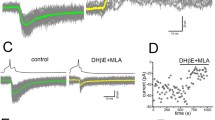Abstract
ALTHOUGH many factors need to be considered before a chemical compound can be identified as a synaptic transmitter substance within the nervous system1, it is essential that, when administered to the appropriate subsynaptic receptors, it evokes the same response of the particular neurones as does the synaptically released transmitter. The demonstration of such a postsynaptic action is, however, insufficient by itself to warrant the assumption that an agent is a transmitter. Thus the conclusion that acetyl-choline is an excitatory transmitter of Renshaw cells is based not only on the excitatory action of this substance but also on the very close similarity between the pharmacology of this excitation, the pharmacology of the synaptic excitation of these neurones by volleys in motor axon collaterals and the pharmacology of the mammalian neuromuscular junction2–3. Recently, the sensitivity of neurones in the cerebral cortex to electrophoretically administered acetylcholine4,5 has led to the suggestion that such cells may be activated synaptically by cholinergic fibres5. However, no details have been given of the effect of pharmacological agents on the synaptic excitation of these neurones; moreover, the reported pharmacology of the excitation by acetylcholine differs in certain respects from that of the excitation of Renshaw cells by this choline ester.
Similar content being viewed by others
References
Paton, W. D. M., Ann. Rev. Physiol., 20, 431 (1958).
Eccles, J. C., Eccles, R. M., and Fatt, P., J. Physiol., 131, 154 (1956).
Curtis, D. R., and Eccles, R. M., J. Physiol., 141, 435, 446 (1958). Curtis, D. R., Phillis, J. W., and Watkins, J. C., ibid., 158, 296 (1961).
Krnjević, K., and Phillis, J. W., Experentia, 17, 469 (1961).
Krnjević, K., and Phillis, J. W., Experentia, 18, 170 (1962).
Curtis, D. R., and Davis, R., J. Physiol. (in the press).
Curtis, D. R., and Phillis, J. W., J. Physiol., 153, 17 (1960). Curtis, D. R., and Ryall, R. W. (unpublished observations).
Author information
Authors and Affiliations
Rights and permissions
About this article
Cite this article
CURTIS, D., ANDERSEN, P. Acetylcholine: a Central Transmitter?. Nature 195, 1105–1106 (1962). https://doi.org/10.1038/1951105a0
Issue Date:
DOI: https://doi.org/10.1038/1951105a0
- Springer Nature Limited
This article is cited by
-
Influence of microelectrophoretically applied acetylcholine on the responsiveness of hippocampal and lateral geniculate neurones
Pfl�gers Archiv European Journal of Physiology (1968)
-
Localization of acetylcholinesterase in the guinea pig cerebellar cortex
Acta Neurovegetativa (1967)
-
Topical application of drugs to subcortical brain structures and selected aspects of electrical stimulation
Ergebnisse der Physiologie Biologischen Chemie und Experimentellen Pharmakologie (1967)
-
Central Actions of Psychotomimetics
Nature (1963)
-
Excitation of Cerebellar Neurones by Acetylcholine
Nature (1963)





